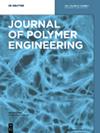An experimental investigation of flame retardancy and thermal stability of treated and untreated kenaf fiber reinforced epoxy composites
IF 1.7
4区 工程技术
Q4 POLYMER SCIENCE
引用次数: 0
Abstract
Abstract Natural fiber reinforced polymeric composites perform poor in mechanical and thermal properties at elevated temperatures due to the cellulose and hemicellulose contents of natural fiber start degrading at elevated temperature. In this research work, flame retardancy and thermal stability of treated and untreated kenaf fiber reinforced epoxy composites have been experimentally investigated and reported. Two composite laminates, one with 6 % NaOH Alkali treated and another with untreated woven kenaf mats, were fabricated by hand lay-up technique followed by compression molding with 40 % fiber weight fractions. Flame retardancy test and various thermal characteristics studies such as thermogravimetric analysis (TGA), differential scanning calorimetry (DSC), heat deflection temperature (HDT), and morphological analysis via scanning electron microscopy (SEM) tests were carried out. The results showed that alkali treated kenaf fiber composite achieved V0 fire retardancy grade. The major weight losses, 86 % and 75.5 % for untreated and treated composites respectively were recorded between 300 °C and 450 °C. 13.6 % increase in HDT was noted for treated composite with 0.25 mm deflection at 0.45 MPa pressure condition. Thus the composite laminate with 6 % NaOH alkali-treated kenaf fiber achieved the best thermal stability with less degradation which is more suitable for automobile and aerospace applications.处理和未处理的红麻纤维增强环氧复合材料的阻燃性和热稳定性的实验研究
摘要天然纤维增强聚合物复合材料在高温下的力学性能和热性能较差,这是由于天然纤维中的纤维素和半纤维素在高温下开始降解。在本研究工作中,对经过处理和未经处理的红麻纤维增强环氧复合材料的阻燃性和热稳定性进行了实验研究和报道。采用手工铺层后加压成型的方法制备了两种复合层压板,一种是6% NaOH碱处理的层压板,另一种是未经处理的编织红麻垫。进行了阻燃试验和各种热特性研究,如热重分析(TGA)、差示扫描量热法(DSC)、热偏转温度(HDT)和扫描电镜(SEM)形态学分析。结果表明,碱处理后的红麻纤维复合材料达到了v0阻燃等级。在300°C和450°C之间,未处理和处理的复合材料的主要失重率分别为86%和75.5%。在0.45 MPa压力条件下,变形0.25 mm的复合材料的HDT增加了13.6%。结果表明,6% NaOH碱处理红麻纤维的复合层压板具有较好的热稳定性,降解少,更适合于汽车和航空航天应用。
本文章由计算机程序翻译,如有差异,请以英文原文为准。
求助全文
约1分钟内获得全文
求助全文
来源期刊

Journal of Polymer Engineering
工程技术-高分子科学
CiteScore
3.20
自引率
5.00%
发文量
95
审稿时长
2.5 months
期刊介绍:
Journal of Polymer Engineering publishes reviews, original basic and applied research contributions as well as recent technological developments in polymer engineering. Polymer engineering is a strongly interdisciplinary field and papers published by the journal may span areas such as polymer physics, polymer processing and engineering of polymer-based materials and their applications. The editors and the publisher are committed to high quality standards and rapid handling of the peer review and publication processes.
 求助内容:
求助内容: 应助结果提醒方式:
应助结果提醒方式:


